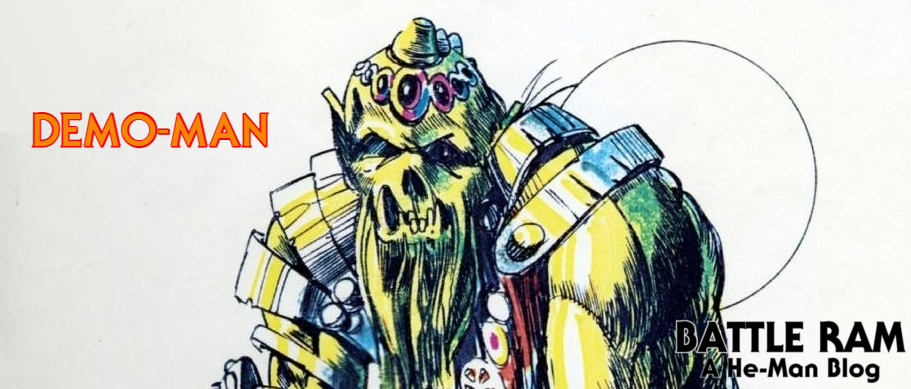
Back in 2009, in the early days of MOTU Classics, a controversial bio was included on the back of Skeletor’s packaging. The bio leaned more or less on the origin story for Skeletor made popular in the Mike Young Productions He-Man and the Masters of the Universe series, where Keldor is mortally wounded in a failed acid attack against Randor. His face is badly burned, and his life is saved by Hordak. In the process he becomes Skeletor. But in the Classics bio, a new detail was added. Keldor was merged with an initially-unnamed extra-dimensional being as part of his process of healing and becoming Skeletor. The name of the being was initially withheld until Mattel had the rights to the name Demo-Man. Fans reacted negatively, reasoning that Skeletor shouldn’t need to be combined with some other being to become the evil Skeletor.
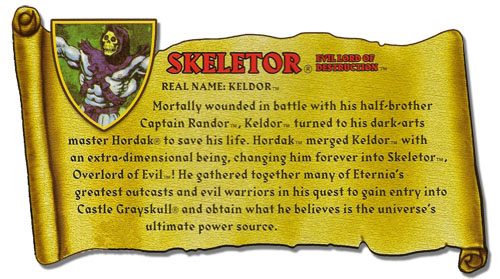
Once the rights to Demo-Man were secured, this updated bio was used, adding “the extra-dimensional being Demo-Man from Despondos.”

Two years later, when the Demo-Man figure was released, his bio gave some additional details to the merger with Keldor, although no real information about Demo-Man himself was provided. Part of the purpose of this exercise was to explain away early minicomic canon that contradicted later canon. Skeletor’s attempt to bring “his people” to Eternia is retconned as temporary insanity brought on by his having merged with Demo-Man. In the bio story, Hordak would have used this delusion as an opportunity to have Skeletor bring him to Eternia. Of course as any historian will tell you, when you try to harmonize two contradictory stories, you just end up creating a third contradictory story. MOTU has many, many contradictory canons, which keep multiplying over the years as the property is continually rebooted. I think that’s why many fans seem to have their own personal preferred canons, often incorporating novel ideas of their own. The story has never been tightly controlled.
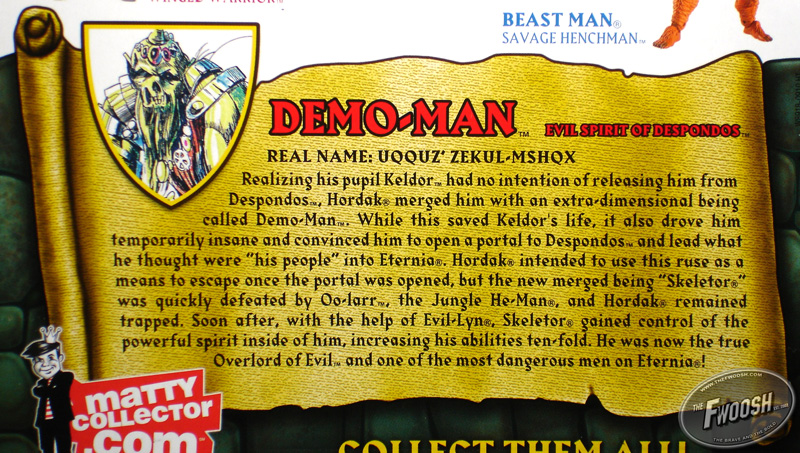

So why was Demo-Man put into Skeletor’s bio in the first place? Well, the ethos in the days of MOTU Classics was to try to retcon certain concepts and variant characters as new characters. A good example of this is “Oo-Larr,” a representation of the first appearance of He-Man in the original He-Man and the Power Sword minicomic. In Classics canon, he was retconned as a different character from He-Man, because this version of He-Man was a Tarzan-like warrior with no Prince Adam alter ego, and his backstory is unique and contradicted later stories.

Other examples include Vikor and Vykron, who were early concepts that were retconned into their own separate characters. I’ve never really understood the reasoning for this. At the time the explanation was that it would “justify” making figures of these designs if they were separate characters. However, the Classics line was chock-full of He-Man variants, so it’s hard to see why this justification was ever needed. In the end it was probably just the preference of the brand manager at the time, who was trying to create his own overarching story for the brand, encompassing all eras of MOTU. Retconning early contradictory ideas made the bios easier to write.
Anyway, in the early days of the Classics line, some Mark Taylor concept art was circulating among fans, depicting a green, bearded orc-like character with a rotting skull face. It was undated and unlabeled. There is no obvious connection to Skeletor, other than the decaying face. At the same time the brand manager had found a list of potential names for characters in Mattel’s archives. One early name for Skeletor, per his recollection, was Demo-Man (although the name De-Man or D Man is what appears on Skeletor B-sheets). But again, this name did not appear anywhere on the green character’s artwork.


This was the explanation given at the time by the brand manager (user name: Toyguru) on the He-Man.org forums:

So, the assumption was made that the green bearded character was an early Skeletor concept called Demo-Man, and that’s what was written into the bios, as a way of paying homage to it. It’s been a prevailing assumption ever since.
However, since 2016, we’ve known definitively that this character was not an early Skeletor concept. How do we know this? I went to the source himself:
Battle Ram Blog: There is a character you designed who fans refer to now as Demo-Man. Do you see him as an early incarnation of Skeletor or Beast Man?
Mark Taylor: No, he was a separate concept that I was too busy to exploit, I was working until the sun came up and the Mattel building was empty. I was pretty much running on fumes. I would have loved to take him further but like so many concepts corporate profit came first.
I’ve included this information of course in the original interview, and in my old article about Skeletor. The interview with Mark also appeared in the Dark Horse Toys of He-Man and the Masters of the Universe. So why point this out again in another article? For one, because the misconception about this character still exists in the fan community. But the other reason is, I love the design of Demo-Man, and this is a chance to talk about him a little.
Now, I should point out that although the character wasn’t initially named by Mark, he was given a name when he was released several years ago in a portfolio of sketches. The name Mark chose for him was “The Merciless.” He also recolored it with a darker color palette.
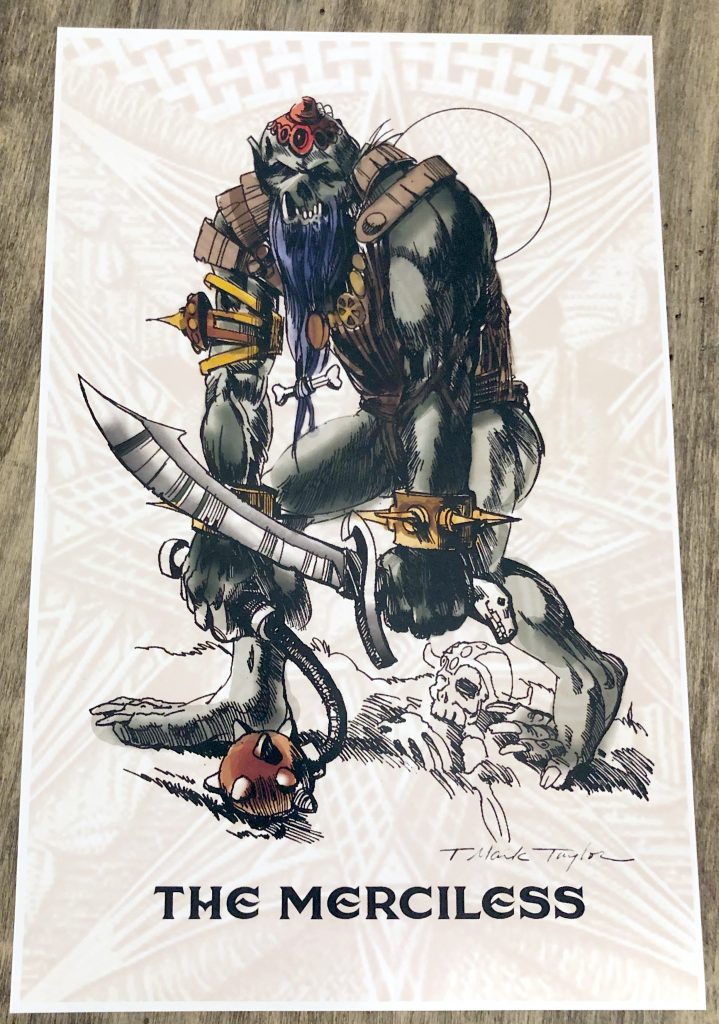
Because Demo-Man is the name fans know the character as, that’s the name I’ll continue to use in this article, but I just wanted to point out Mark’s name for him.
Demo-Man has only been released in MOTU once so far, in 2011 in the MOTU Classics line. The prototype figure was shown off at the 2011 San Diego Comic-Con. The figure was a painstaking recreation of Mark Taylor’s drawing, up to and including the helmeted skull at the character’s feet and the tuft of hair sticking out from the character’s back. Below are images of the prototype that was displayed at San Diego Comic-Con (images are from ToyArk and Toy News International):



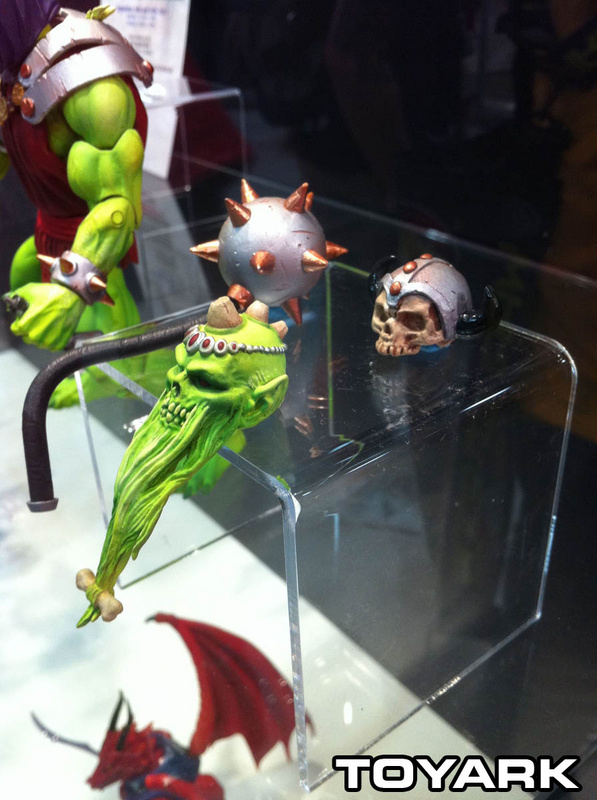
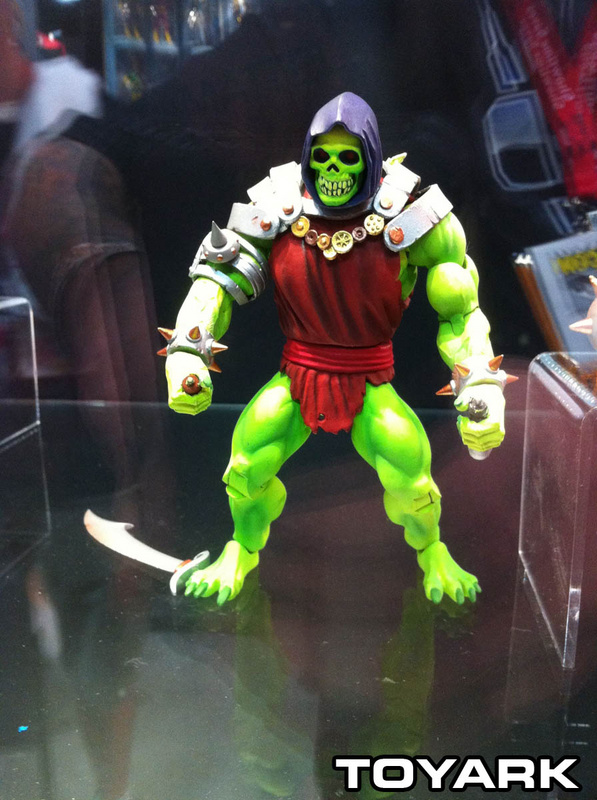
Because of Demo-Man’s association with Skeletor in the Classics bios, he also came with an extra Skeletor head, based on the character’s depiction by Alfredo Alcala. This head became the default head for many fans. I’ll just note that when modern designers want to make Skeletor look more scary, they’ll often give him “angry” eyes, an expression that really isn’t possible on a skull (skulls don’t have eyebrow muscles). The Alcala Skeletor head is noted as probably the creepiest and most impressive head for the figure ever made, and he has large, round eye sockets and oversized, crooked teeth. You don’t need to go the Spirit Halloween route to make a truly wicked-looking Skeletor.

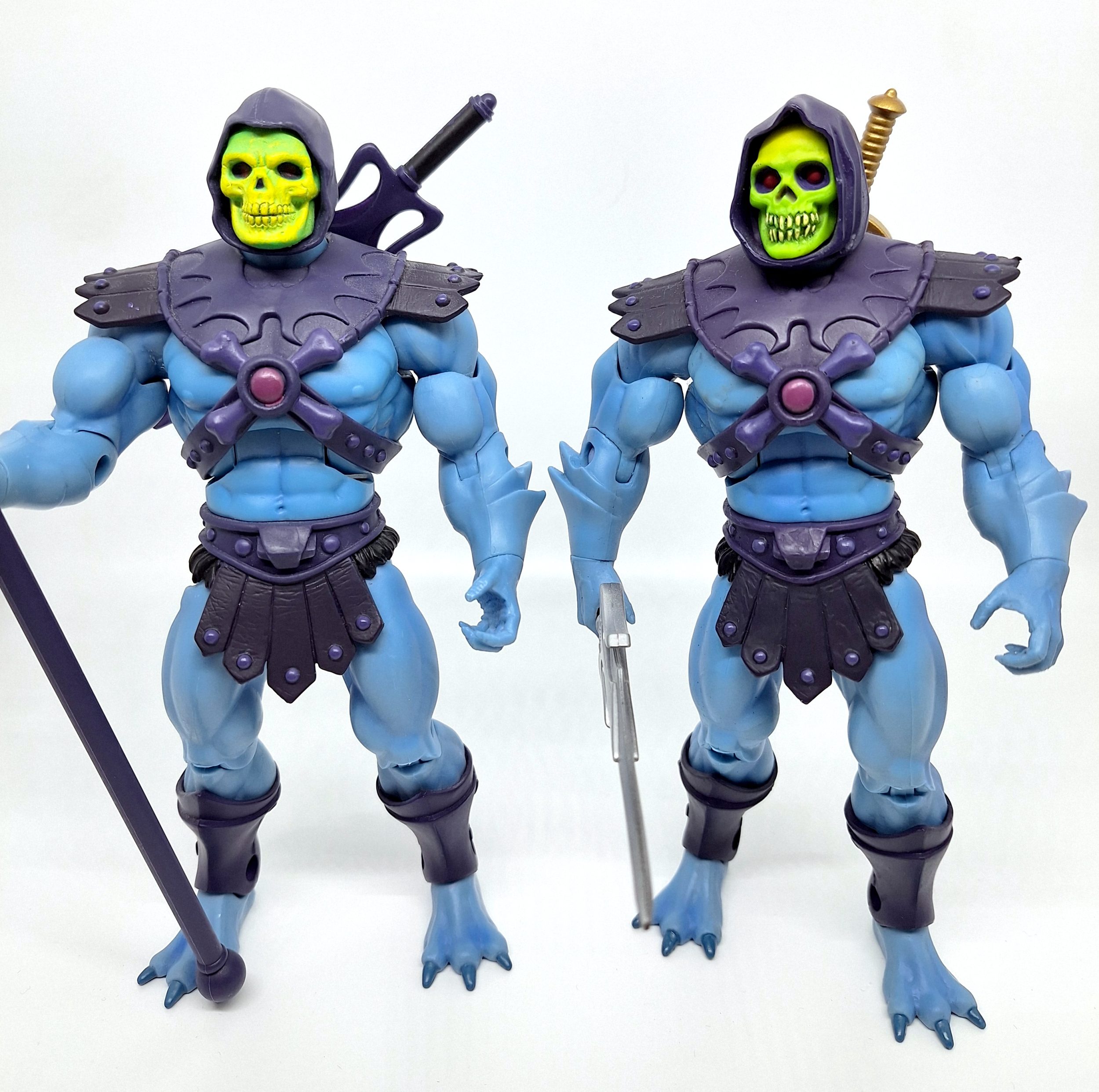
The production Demo-Man figure (below) was a bit different from the prototype in a few different ways.
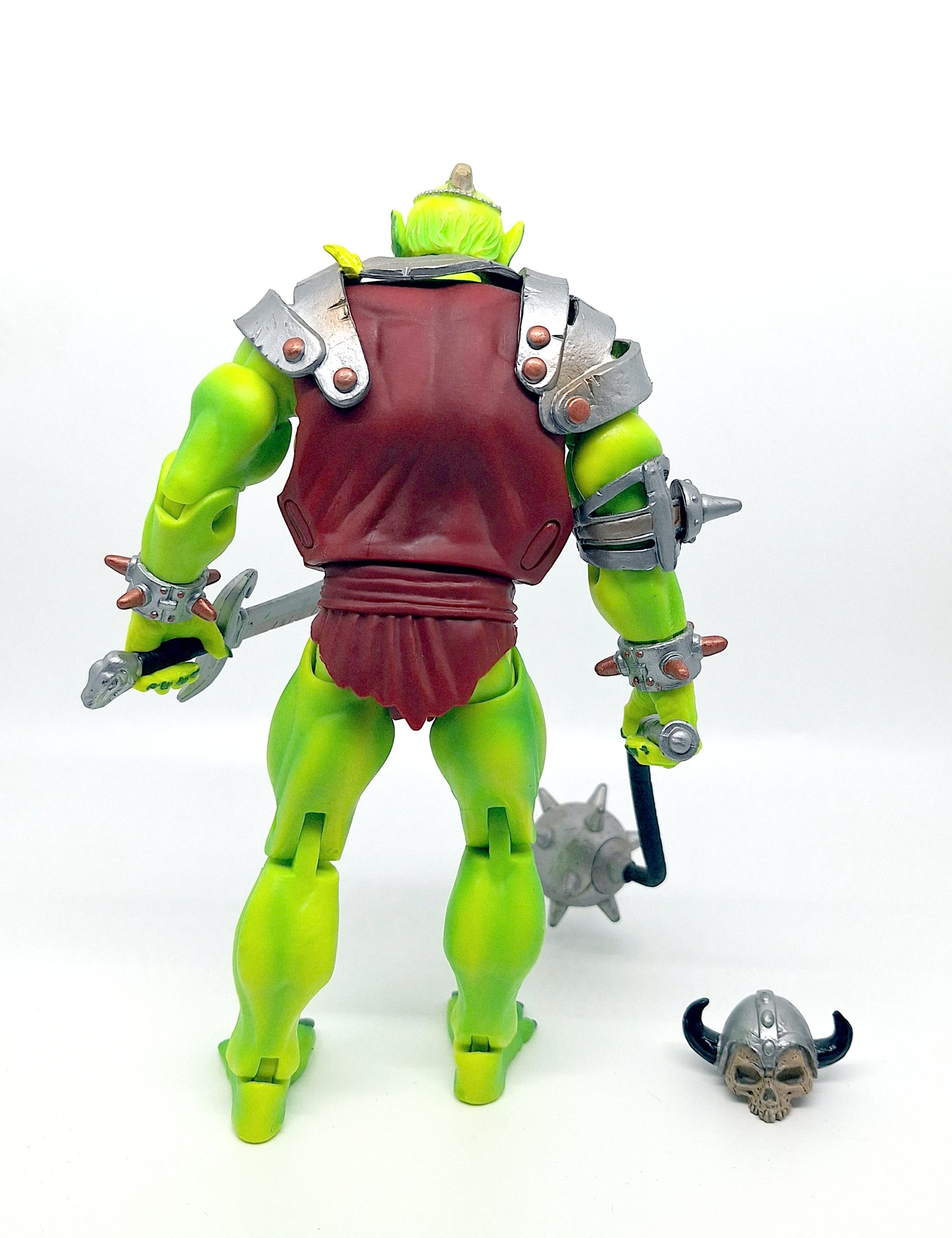

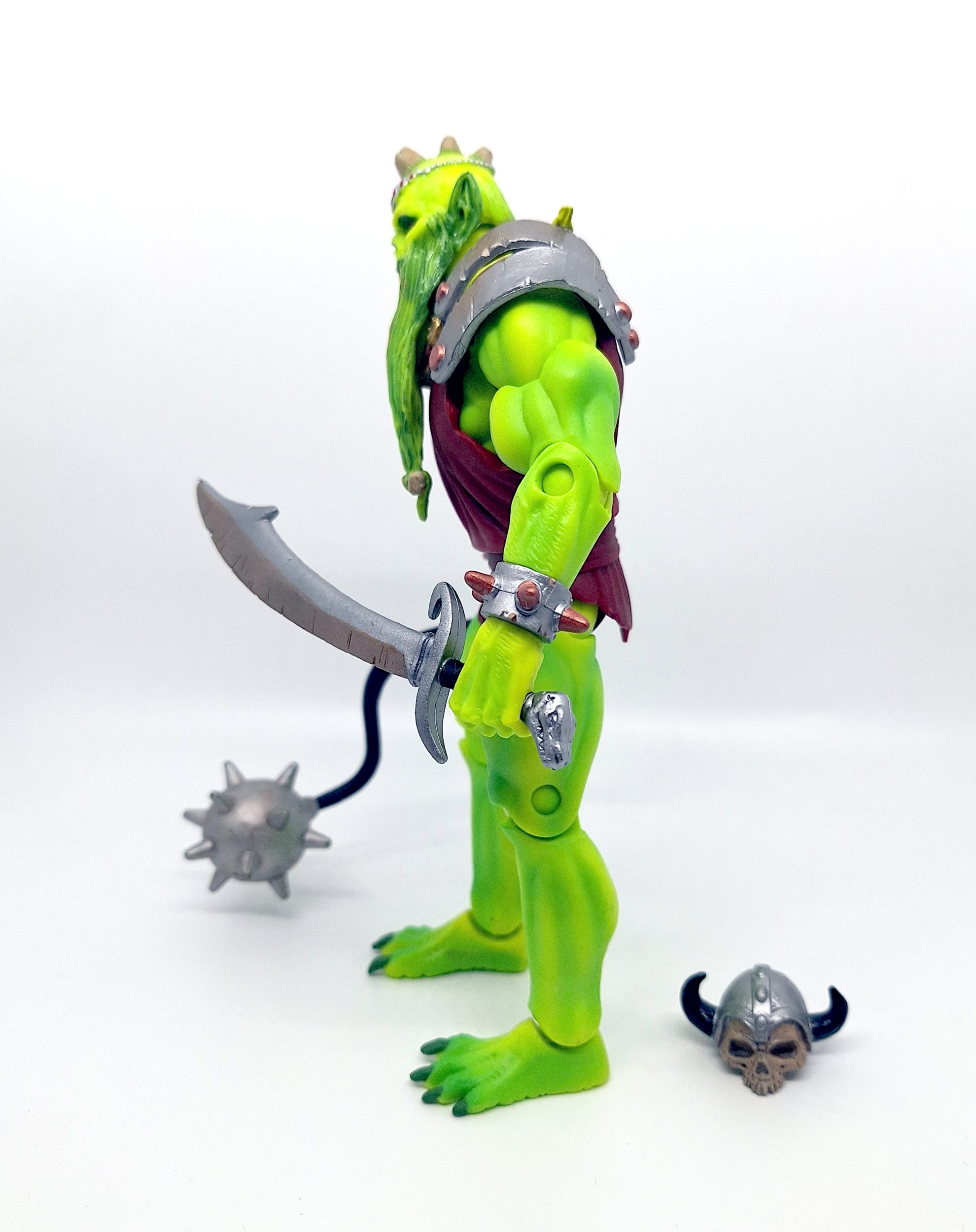
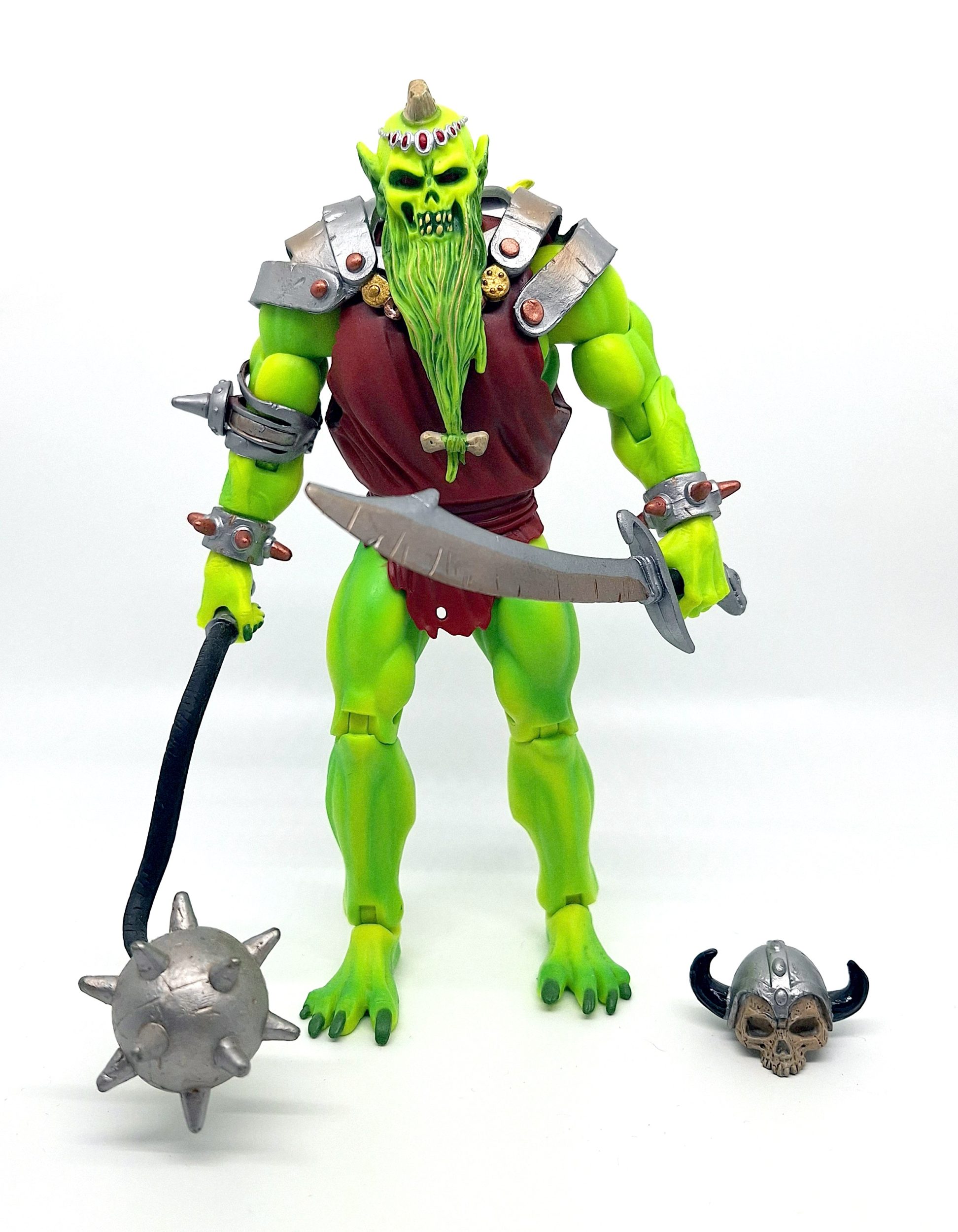
The copper accents were removed from both the flail weapon and the rivets on the skull’s helmet. Copper was also used as a rust analogue on all silver areas of the prototype, but it’s cut down a bit on the production figure, and doesn’t appear at all on the skull’s helmet. The spikes on the figure’s gauntlets and flail have been dulled down for safety. The overall skin color of Demo-Man is brighter as well – he is cast in a very bright yellowish color with plenty of green overspray. The bonus Alcala Skeletor head’s face also features these colors. The paint work on Demo-Man’s face isn’t quite as sharp as the prototype version, but of course that’s to be expected. No factory could match a finely hand-painted prototype.
Earlier I mentioned that lots of MOTU fans have their own head canon. I actually have one of my own regarding Skeletor and Demo-Man. I don’t follow the Classics idea of Demo-Man being an entity existing inside Skeletor. However, that story did inspire another take I thought of while looking at the two figures together.
In my little head canon, Eternia is a place full of incorporeal demons. Everyone knows that you have to quickly cremate your dead or protect them with a spell, otherwise a roaming demon will find it, take possession of the body, and walk around in it, causing mayhem. Skeletor arose this way, when a young warrior fell in battle, and his comrades could not recover the body because of the weight of his armor and the group of enemies pursuing them. The young fallen warrior laid there dead on the battlefield for a time, his face eaten by scavengers. Eventually a powerful, ancient demon found him and took possession of him, and he became known as Skeletor. Demo-Man was a solitary wandering orc who met with a similar fate on the side of a mountain. Part of the point of this story is to explain the skull faces on these characters and also make them contemporaries of each other who could actually work together. This would put Demo-Man as one of Skeletor’s evil warriors, albeit at a higher level than his usual non-demonic flunkies.
Now, just because Demo-Man isn’t a Skeletor concept, doesn’t mean you can’t accept the Classics canon about his role in Skeletor’s origins. The fictional MOTU storylines are an altogether different subject from the history of the development of these toys. At the end of the day, you can think of him however you like, or discount him altogether. It’s up to you. But hopefully this article has been an informative and entertaining look at Demo-Man.
Thank you to the following individuals who are current Patreon supporters!
- Ben M.
- Matthias K.
- Max I.
- MotuOriginsCork
- Orion W.
- Philip O.
- Robert B.
- That Clyde Guy
Want to support the blog? Consider becoming a Patreon supporter. You’ll also gain access to exclusive content and early access to posts on the blog. Alternatively, you can do your toy shopping through my Entertainment Earth affiliate link, below. Thank you!
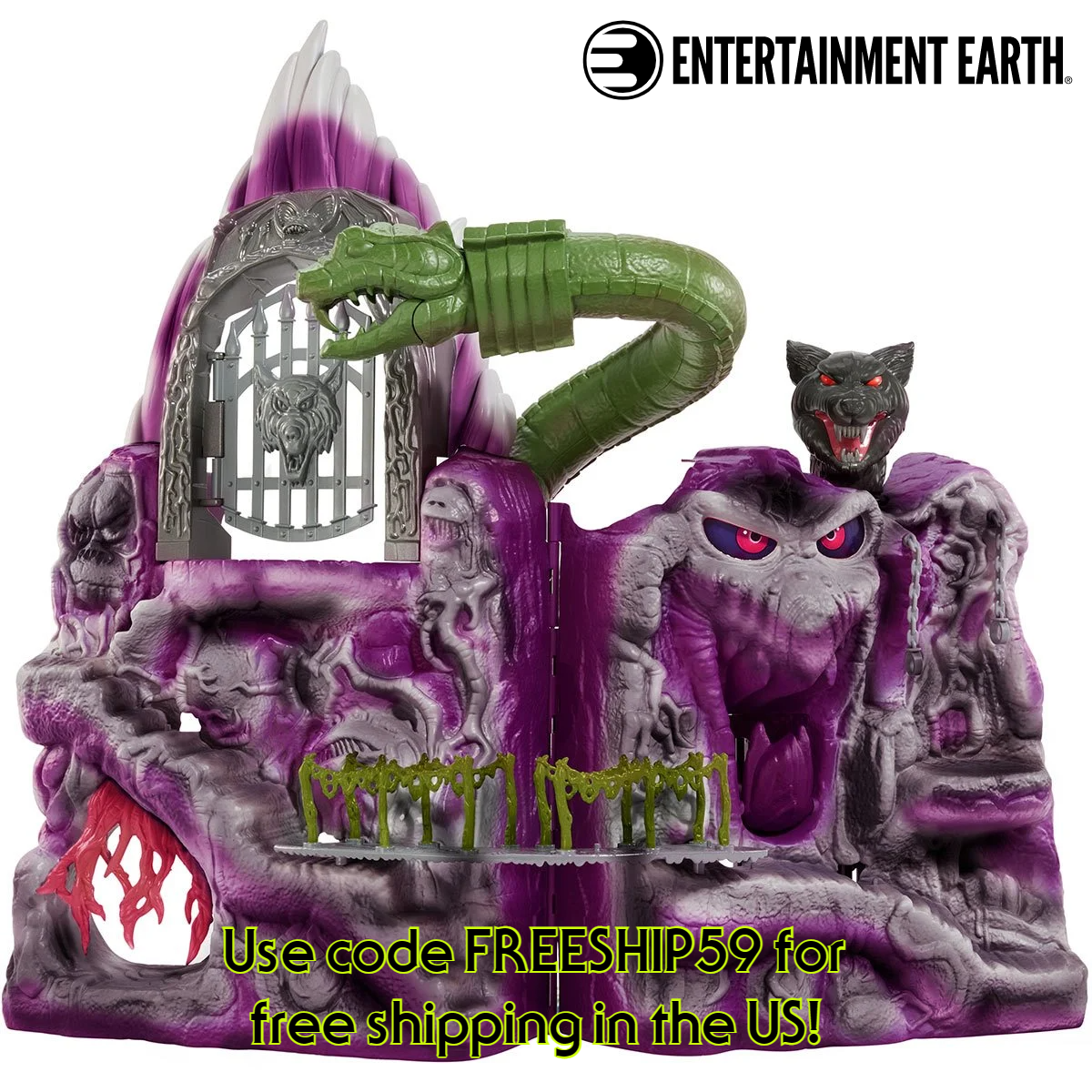
Nice to see a spotlight on this character, as I’ve been fascinated with that concept art since it was first shared publicly. I never really bought it as a Skeletor concept, however; aside from the partially decayed face, they really have nothing in common. However they justified it, I’m glad we got the figure. The concept figures like this were my favorite stuff in the Classics line. And that Alcala head is nearly perfect. That simply IS Skeletor. Whenever I think of the character, that is what I picture in my mind’s eye. Like you said, this design is infinitely more creepy and unsettling than giving him “angry eyes.” The round sockets and neutral expression give him the air of one who is above all he surveys; he regards you as he would an insect. He is a being above morality, to whom compassion is an unknown concept. As I said of that head sculpt when I reviewed it ages ago, “This mother****er looks like he eats babies for fun.” One of the great injustices of the numerous incarnations of MOTU over the decades is that this original, most pure version of the the ultimate enemy never got his due. He very quickly became simplified in the typical bumbling cartoon adversary, only elevated above the pack by Oppenheimer’s excellent performance. That version quickly bled into other media, and became how virtually everyone sees the character, especially outside of the fandom. The closest we really got to seeing this version of the character done justice is Langella’s portrayal in the 1987 movie.
Looking back over all that, it’s a bit of a rant. Sorry! 😂
Thanks Waylon! I don’t actually mind the Classics backstory for Skeletor/Keldor that much. As you say, the mistaken identity of Demo-Man is probably why we got a figure of him, so I’m glad it happened that way. And I agree, the Alcala Skeletor head is a work of art! But I do still hear on social media about Demo-Man being an early Skeletor concept, so this is to help combat that.
Fun article! Thank you!
As for why they did Vikor and Vykron and all those “He-Men,” the way Scott Neitlich described it in his videos was that yes, he wanted to make those nifty concepts into figures for the deep-cut fans without going the “Star Wars” route and give them unwieldy names like “McQuarrie Concept Art Chewbacca,” for example.
Plus, it helps expand the mythos and gives us more stuff to enjoy, as far as I’m concerned. I’m always happy to have more of what I enjoy, especially if it can link up with the established stuff. It’s like you say — there are so many different and frequently conflicting backstories in MOTU. It’s nice that an attempt was made to make them all come together in one narrative.
The other route was explored in the “Masters of the Multiverse” comics series, which I also enjoyed, but nowadays, the “multiverse” card is getting played way too often, I think. Have you read the “Masters of the Multiverse” trade paperback? Amazing use of the differing art styles throughout MOTU history. A real visual treat, even if you’re not completely on board with the plot.
Yeah, it’s a tough decision – do you go multiverse route or retcon route? Personally I would have been fine with Vykron as “Early Concept He-Man.” I mostly ignored the Classics bios at the time, and I still don’t think of them as the one true canon (I don’t think such a thing exists). There are some good and bad things about them, it’s a mixed bag. But that’s just my subjective opinion. Probably the most popular canon is what was established in Filmation. But because there was no tight control on it, there were many, many different versions of the story in the vintage line, and the number of canons keep multiplying with every new reboot.
Speaking of head-canon, I’ve never understood nor agreed with the need to syncretize the many variations of the mythos into a multi-headed composite. I prefer to look at the whole as a series of legends which may be true, false, a little A and B, or something totally different (in the case of new canon).
Besides, Demo-Man always looked more like a precursor of Beast Man than Skeletor to me.
The really intriguing thing about the Classics bio for Skeletor for me is how it tracked with a dubious statement from the early days of Adam Tyner’s mailing list. It’s been over twenty-five years, so I may be misremembering the details, but apparently someone or their friend got in touch with someone at Mattel about who this ‘Scare Glow’ character was and was told the following:
Scare Glow was the evil inside Skeletor. Long ago, Skeletor had been judged by the Council of Elders and bound to an evil entity that cursed him with the skull face we know him for, as well as dooming him to a slow death. This could be healed only by his repentance or by capturing the Power Sword. Scare Glow would be released if Skeletor died in this state, so he whispered in his mind to both keep him from repenting and causing him to make mistakes in his search for the sword. The figure we got is what happens when Skeletor finally dies of the curse and Scare Glow is set free upon Eternia.
Urban legend? Probably. But this dates from 1996, and it’s interesting how it gels with the later revelations that Keldor was supposed to be a Powers of Grayskull antagonist. Whether Neitlich heard this same story and was consciously or unconsciously inspired by it in crafting the Skeletor bio, or whether there’s something more there … impossible to say.
Personally, my headcanon for Demo-Man is that he’s a Preternian villain, enemy of He-Ro, and master of the Slime Swamp, which was much more horrible in those early days, with its life-draining, will-devouring slime that threatened to burst forth over the lands. Hordak would secretly take some of that slime and later apply its principles to create the Slime Pit. 🙂
As for unified canon, I actually made my attempt at that as a thought experiment back in the 90s as well, when we had much less to work with … and even then, I couldn’t get the original 4 mini-comics to fit in.
Interesting stuff Matthew. I wasn’t on those early mailing lists or the early days of the Org, so I missed stuff like this!
Thanks for mythbusting Demo-Man!!